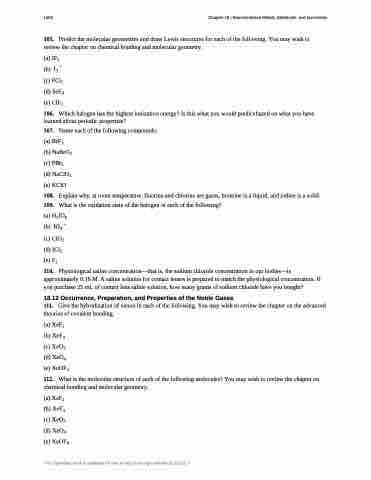Page 1060 - Chemistry--atom first
P. 1060
1050 Chapter 18 | Representative Metals, Metalloids, and Nonmetals
105. Predict the molecular geometries and draw Lewis structures for each of the following. You may wish to review the chapter on chemical bonding and molecular geometry.
(a) IF5
(b) ���
(c) PCl5
(d) SeF4
(e) ClF3
106. Which halogen has the highest ionization energy? Is this what you would predict based on what you have learned about periodic properties?
107. Name each of the following compounds: (a) BrF3
(b) NaBrO3
(c) PBr5
(d) NaClO4 (e) KClO
108. Explain why, at room temperature, fluorine and chlorine are gases, bromine is a liquid, and iodine is a solid.
109. What is the oxidation state of the halogen in each of the following?
(a) H5IO6 (b) ���� (c) ClO2 (d) ICl3 (e) F2
110. Physiological saline concentration—that is, the sodium chloride concentration in our bodies—is approximately 0.16 M. A saline solution for contact lenses is prepared to match the physiological concentration. If you purchase 25 mL of contact lens saline solution, how many grams of sodium chloride have you bought?
18.12 Occurrence, Preparation, and Properties of the Noble Gases
111. Give the hybridization of xenon in each of the following. You may wish to review the chapter on the advanced theories of covalent bonding.
(a) XeF2
(b) XeF4
(c) XeO3
(d) XeO4
(e) XeOF4
112. What is the molecular structure of each of the following molecules? You may wish to review the chapter on chemical bonding and molecular geometry.
(a) XeF2 (b) XeF4 (c) XeO3 (d) XeO4 (e) XeOF4
This OpenStax book is available for free at http://cnx.org/content/col12012/1.7


